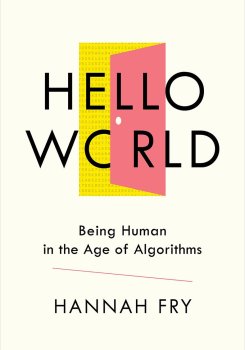How Did A Computer Beat A Chess Grandmaster?
Some say Garry Kasparov was more than capable of defeating Deep Blue—but he underestimated the ability of the algorithm.
The following is an excerpt of Hello World by Hannah Fry.
Garry Kasparov knew exactly how to intimidate his rivals. At 34, he was the greatest chess player the world had ever seen, with a reputation fearsome enough to put any opponent on edge.

Hello World: How Algorithms Will Define Our Future and Why We Should Learn to Live with It
Even so, there was one unnerving trick in particular that his competitors had come to dread. As they sat, sweating through what was probably the most difficult game of their life, the Russian would casually pick up his watch from where it had been lying beside the chessboard, and return it to his wrist. This was a signal that everybody recognized–it meant that Kasparov was bored with toying with his opponent. The watch was an instruction that it was time for his rival to resign the game. They could refuse, but either way, Kasparov’s victory was soon inevitable.
But when IBM’s Deep Blue faced Kasparov in the famous match of May 1997, the machine was immune to such tactics. The outcome of the match is well known, but the story behind how Deep Blue secured its win is less widely appreciated. That symbolic victory, of machine over man, which in many ways marked the start of the algorithmic age, was down to far more than sheer raw computing power. In order to beat Kasparov, Deep Blue had to understand him not simply as a highly efficient processor of brilliant chess moves, but as a human being.
For a start, the IBM engineers made the brilliant decision to design Deep Blue to appear more uncertain than it was. During their infamous six-game match, the machine would occasionally hold off from declaring its move once a calculation had finished, sometimes for several minutes. From Kasparov’s end of the table, the delays made it look as if the machine was struggling, churning through more and more calculations. It seemed to confirm what Kasparov thought he knew; that he’d successfully dragged the game into a position where the number of possibilities was so mind-bogglingly large that Deep Blue couldn’t make a sensible decision. In reality, however, it was sitting idly by, knowing exactly what to play, just letting the clock tick down. It was a mean trick, but it worked. Even in the first game of the match, Kasparov started to become distracted by second-guessing how capable the machine might be.
Although Kasparov won the first game, it was in game two that Deep Blue really got into his head. Kasparov tried to lure the computer into a trap, tempting it to come in and capture some pieces, while at the same time setting himself up several moves ahead–to release his queen and launch an attack. Every watching chess expert expected the computer to take the bait, as did Kasparov himself. But somehow, Deep Blue smelt a rat. To Kasparov’s amazement, the computer had realized what the grandmaster was planning and moved to block his queen, killing any chance of a human victory.
Kasparov was visibly horrified. His misjudgment about what the computer could do had thrown him. In an interview a few days after the match he described Deep Blue as having “suddenly played like a god for one moment.” Many years later, reflecting on how he had felt at the time, he would write that he had “made the mistake of assuming that moves that were surprising for a computer to make were also objectively strong moves.” Either way, the genius of the algorithm had triumphed. Its understanding of the human mind, and human fallibility, was attacking and defeating the all- too-human genius.
Disheartened, Kasparov resigned the second game rather than fighting for the draw. From there his confidence began to unravel. Games three, four and five ended in draws. By game six, Kasparov was broken. The match ended Deep Blue 3½ to Kasparov’s 2½.
It was a strange defeat. Kasparov was more than capable of working his way out of those positions on the board, but he had underestimated the ability of the algorithm and then allowed himself to be intimidated by it. “I had been so impressed by Deep Blue’s play,” he wrote in 2017, reflecting on the match. “I became so concerned with what it might be capable of that I was oblivious to how my problems were more due to how badly I was playing than how well it was playing.”
As we’ll see time and time again in this book, expectations are important. The story of Deep Blue defeating the great grandmaster demonstrates that the power of an algorithm isn’t limited to what is contained within its lines of code. Understanding our own flaws and weaknesses–as well as those of the machine–is the key to remaining in control.
But if someone like Kasparov failed to grasp this, what hope is there for the rest of us? Within these pages, we’ll see how algorithms have crept into virtually every aspect of modern life–from health and crime to transport and politics. Along the way, we have somehow managed to be simultaneously dismissive of them, intimidated by them and in awe of their capabilities. The end result is that we have no idea quite how much power we’re ceding, or if we’ve let things go too far.
Excerpted from Hello World: Being Human in the Age of Algorithms by Hannah Fry. © 2018 by Hannah Fry Limited. Used with permission of the publisher, W.W. Norton & Company, Inc. All rights reserved.
Hannah Fry, Ph.D., is a lecturer in the Mathematics of Cities at the Centre for Advanced Spatial Analysis at UCL, and is co-author of The Indisputable Existence of Santa Claus (The Overlook Press).